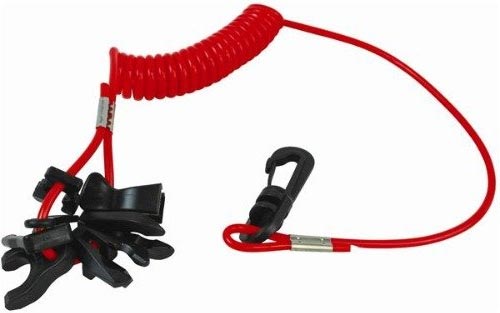
It should kill the engine, but failure to use it may kill you!
It is not an optional extra – it is there to protect you!
Motor powered water craft are more popular than ever. The kill cord (or Safety Lanyard Cord) is a simple marine safety device for motorboats, RIBs, jet skis etc. which ensures that, should the helmsman be separated from the helm for any reason, the engine will stop. It is just as important as a life jacket or buoyancy aid.
The kill cord is a strong plastic coated cable or coiled lanyard, red in colour and with a core made of either wire or thin rope. On one end is a quick release fitting that clips onto the engine's kill switch and on the other end is a karabina which is attached to the helmsman. If the helmsman is thrown overboard or moves away from the helm for any reason, the cord would be pulled from the kill switch, cutting power to the engine and stopping the craft. The kill cord is best attached around the driver's knee and clipped back on itself. This will allow the helmsman to use both hands without restriction, it will prevent the kill cord from snagging on something and detaching itself from the helmsman and it should stop it fouling the steering or gear controls.
This simple device would seem to be foolproof, but like most things it does depend on us using a certain amount of common sense and making sure we use the device as it is intended.
- Although most engines will not start without the kill cord in place, this safety device is not on every boat, so don't forget it, even if you are in a hurry and it means going back to collect it.
- Don't clip it onto an item of clothing or anywhere else where it could release from the driver rather than the engine.
- Don't use a cord which is longer than the one provided by the manufacturer. It may allow you more movement, but it could result in the kill cord not doing its job properly.
- If you change drivers, stop the engine, secure the kill cord to the new driver and then restart the engine.
- When coming alongside use the kill cord to stop the engine as soon as your boat is secure.
- Make sure the cord is in good condition and test regularly to ensure that the engine stops when it is pulled.
- Monitor it regularly for signs of wear, rust and reduced elasticity and replace it when it starts to deteriorate.
- When replacing a kill cord chose a good quality lanyard with a strengthening cord through the middle.
- Don't leave kill cords exposed to the elements, as extremes of temperature and sunlight will damage the cord.
Part 2: Kill cord accidents and lessons >
Author – Dee White